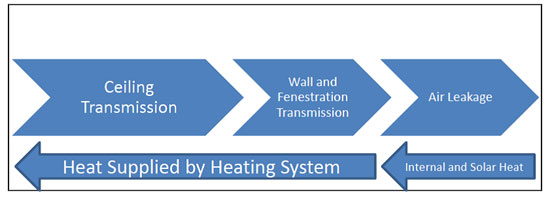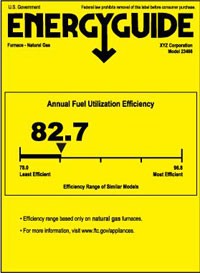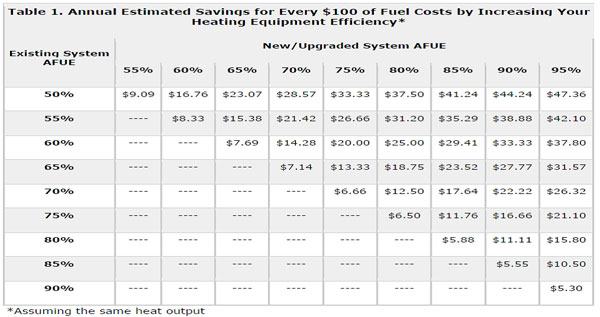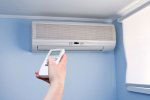by C. Weiner* (7/19)
Quick Facts…
- 54% of all energy expenses for the average home in Colorado go toward space heating. Tightly sealed, well insulated homes can be much less expensive to heat than leaky, poorly insulated homes. Older furnaces and boilers can have efficiencies as low as 56%, while new units can achieve efficiencies of almost 99%.
- All buildings use less heating energy when the thermostats are set at lower temperatures, but some central heating systems work better with thermostat adjustments than others.
Heating is the single largest energy expense for most Colorado households. A variety of fuel sources—including natural gas, propane, electricity, and wood—make options for heating homes plentiful but potentially overwhelming. Great variety in performance and efficiencies can exist within similar types of heating equipment, and a holistic approach to reducing heating energy expenses is often not considered. This fact sheet is intended to introduce a wide range of heating options for Colorado homes and provide guidance on heating efficiently both through reducing energy demand and by utilizing efficient equipment. Topics covered include figuring out your heating costs, the whole house approach to heating efficiency, different types of heating equipment, controlling your heating system, and other considerations.
How Much Do You Pay For Heating
| Month | Therms |
| J | 140 |
| F | 151 |
| M | 110 |
| A | 72 |
| M | 55 |
| J | 23 |
| J | 15 |
| A | 16 |
| S | 39 |
| O | 80 |
| N | 91 |
| D | 129 |
| Total | 921 |
An average of 54% of all energy expenses for the average home in Colorado goes toward space heating. There can be tremendous variation in heating costs for tightly sealed, well insulated homes compared to leaky, poorly insulated homes. To figure out how much is spent to heat your home per year all you need is one year’s worth of energy bills from your local utility. Since approximately 75% of all homes in the state use natural gas as the primary fuel for heating, we’ll go through an example using the common unit of therms (see table).
First, identify the three months of lowest natural gas use–typically June, July, and August. Then calculate the average of those months: 23 + 15 + 16 = 54 and 54/3 = 18 therms. This is called the ‘baseload’ and represents the amount of natural gas used per month for functions other than heating (namely domestic hot water and possibly some cooking). Then subtract the baseload from the annual total to calculate heating energy use. To do that, first multiply the 18 therms/month baseload by 12 months = 216 therms/year. When subtracting that annual baseload from the total annual therms of 921, you can see that 705 therms per year is used to heat the home in this example. To determine the cost of these 705 therms, simply multiply 705 times the cost per therm (as indicated on your bills), for example, $0.70:
705 * $0.70 =
$493.50 per year for heating
This calculation is useful for a number of reasons. First, if you don’t know how much you’re currently paying for heating you might not understand how much savings to expect from energy conservation. Second, knowing your annual heating costs and your heating equipment efficiency can help you calculate expected savings from installing high efficiency equipment (more on that later). Third, when you also calculate your cooling and baseload costs, you should have a better understanding of where to prioritize any investments you’re willing to make into energy efficiency.
Whole House Approach

Adapted from Residential Energy, 5th edition
Rather than purchasing large heating equipment to ensure comfort during the coldest winter days, investing in a building shell will allow for the use of smaller, less costly heating equipment. A quick review of the various routes through which heat leaves houses to the cold outdoors in winter will help to show how this is true (see graphic above).
The arrows above indicate the different ways heat escapes homes—primarily through the ceiling, walls, and fenestration (a.k.a windows) and through various cracks and gaps (air leaks) throughout the home. The arrows pointing to the left describe sources of heat needed to make up for this heat loss—heating equipment, internal heat (i.e. from occupants or appliances), and solar radiation. The object of the wholehouse approach to heating is to minimize heat losses (right-pointing arrows) and to maximize solar heat gain, thereby reducing the heat needed from active heating equipment as much as possible.
To accomplish this, cracks and gaps should be sealed to avoid leakage and insulation should be installed to recommended levels around the boundaries of conditioned spaces as well as around ductwork and hot water pipes (as applicable). See Extension fact sheets on air sealing and insulation for more on those two topics. You can also let the direct winter sun in as much as possible through a south-facing orientation and other passive solar applications for new homes and by managing window treatments like blinds and curtains properly in existing homes.

Source: Residential Energy, 5th edition
The comparison above illustrates how the whole house approach to heating really is effective. As you can see, even average cold climate homes require three times as much heat energy as well insulated homes with low air leakage. Because of this, contractors should always perform a ‘Manual J’ calculation which accounts for the ‘tightness’ and insulation value of the home—among other factors—to determine the proper size of new or
replacement heating equipment.
Central Heating Equipment: Furnaces and Boilers
In Colorado, furnaces and boilers are the most common types of home heating equipment. Furnaces work by burning a fuel source inside a heat exchanger and blowing the heated air into a home’s duct network with a blower. Warm air then enters the home’s rooms through individual heating registers, and air comes back to the furnace through grilles and return ducts. Boilers work similarly except that heat is transferred to water instead of air and then hot water or steam is distributed throughout the home before returning to the central unit.
The most common measure of efficiency for furnaces and boilers is Annual Fuel Utilization Efficiency (AFUE). AFUE accounts for all heat lost from the point of combustion to the chimney or vent, but does not account for heat lost in ductwork or piping. It is often listed on the yellow Energy Guide label as shown, but can also be calculated by dividing the output of the unit (in BTUs) by the input of the unit (in BTUs) as listed on the nameplate. Older units can have AFUEs as low as 56%, while new high efficiency units can achieve AFUEs of almost 99%.

The AFUE of a furnace or boiler depends on a number of factors, including how it draws in and vents combustion air and how well the furnace is sized to match the home’s needs.
Features to look for in efficient furnaces or boilers include:
- Condensing units that reheat condensed flue gases;
- Sealed combustion in which air is brought in directly from the outside through a dedicated pipe;
- Fan-assisted venting and supply of
combustion air.
The difference in heating expenses between low and high efficiency units can be significant. When considering the purchase of a new furnace or boiler, use Table 1 (provided by U.S. Department of Energy) to calculate expected savings based on AFUE and current heating costs. (Before using this table calculate how much you currently pay for heating using the method described earlier in this fact sheet.)
For example, let’s assume you are currently paying $493.50 to heat your
home over a year (from the example we used earlier in the fact sheet) with a 70% efficient furnace. By upgrading to a 90% efficient furnace you would save $22.22 for every hundred dollars spent on heating:
$493.50/100 = 4.94 and 4.94 * 22.22 =
$109.77 saved per year
Once you know how much you would save per year, you can easily figure out how quickly you’d get your money back from the new investment.

Note that upgrades to high efficiency sealed combustion units may require a new, smaller chimney liner if the existing chimney will service only a domestic hot water heater. Also note that furnaces and boilers can be fueled by electricity, although this is much less common. Despite AFUEs upward of 95% for electricity-powered units, the expenses associated with electric furnaces and boilers can be much greater than natural gas-fired units with lower AFUEs. Maintenance of furnaces and boilers should include regular tune-ups from qualified technicians and for furnaces should also include cleaning or replacing filters every one to three months during the heating season.
Central Heating Equipment: Heat Pumps
A heat pump is worthy of consideration for households that are already allelectric, want to avoid using combustion gas inside, are interested in moving to net-zero energy, and/or want to provide heating and cooling with a single unit. The two main types of central heat pumps to choose from are air source heat pumps (ASHPs) and ground source heat pumps (GSHPs). ASHPs work similarly to air conditioners but can heat when flowing in reverse: heat is removed from the outdoor air and transferred to the refrigerant flowing through the condenser before being released into the home through the unit’s indoor air handler and ductwork. While older ASHPs became inefficient when trying to remove heat from air less than 40 degrees F, newer ‘cold-climate’ heat pumps can remove heat from air down to 5 degrees F or less. (ASHPs then rely on electric resistance coils or backup furnaces to provide backup heat.) If considering an ASHP, you’ll want to look at the unit’s heating season performance factor (HSPF) and seasonal energy efficiency ratio (SEER) to determine its efficiency. The most efficient units have HSPFs between 8-10 and SEER ratings between 15-18, and can deliver 1.5 to 3 times more heat energy than the electrical energy they consume when installed properly with the correct amount of refrigerant charge. Ductless ‘minisplit’ ASHPs are also available to provide heating or cooling for individual rooms or spaces in a home.

Horizontal loop field photo credit: Air Solutions |
GSHPs transfer heat with the ground instead of the outdoor air. Coils of pipe run from the unit’s indoor pump underground – either horizontally at least 6 feet underground or vertically 250 feet or more underground—in a “loop field”. Horizontal loop fields require more space but can be less expensive to install than vertical loop fields. GSHPs can be more efficient than ASHPs but are also significantly more expensive and land-intensive to install. Like ASHPs, the success of the system depends largely on the quality of the installation. If using electricity from Colorado’s grid to power heat pumps, their greenhouse gas emissions are currently comparable to emissions from high efficiency natural gas furnaces. Over time, however, the environmental benefits from using heat pumps are expected to grow as the grid uses more clean energy.
Central Heating Equipment: Electric Baseboard
Electric baseboard heat is one of the most expensive options for Colorado homes. Dividing the heat into zones and properly controlling each zone via thermostat is essential to keeping electric baseboard heating costs down. The quality of baseboard heaters varies considerably. Cheaper models can be noisy and often control temperature poorly. Look for labels from Underwriter’s Laboratories (UL) and the National Electrical Manufacturer’s Association (NEMA) to ensure that the product meets those safety standards. Compare warranties of the different models you are considering.
Hydronic Distribution Systems
While heating systems like furnaces distribute heat through the air, other equipment such as boilers can heat water for distribution throughout the home. Hot water baseboard heat can provide varying levels of heat to different zones depending on need. Hot water radiant floor systems can also be zoned and are easiest to install during new construction. Although these radiant systems are typically more expensive to install than hot water baseboard systems, they can deliver heat more efficiently and offer a unique type of warmth many enjoy. Radiant tubes can either be installed in the concrete slab of a home, less commonly in a thin layer of concrete or gypsum beneath floors, or in the air space beneath floors. When installed in the home’s slab foundation, the response time when calling for changes to a space’s temperature is extremely slow so as to make setbacks impractical. Installing a thin layer of concrete in a subfloor not connected to the earth may require additional floor support. Installing radiant tubes in the air space beneath floors requires heating the water to hotter temperatures than needed from other radiant floor designs. These more demanding systems work best when the floor is ceramic tile or other highly conductive material and in general cannot make use of lower temperature heat from
solar hot water systems.
Room or Space Heaters
Some households need to provide heat to a room addition or previously unconditioned room, or perhaps have no central heating system. In these cases, options include extending existing heating ductwork/piping or using ductless mini-split heat pumps, wood heat, solar hot air systems, or electric space heaters.

Air handler of a ductless mini-split.
|
Like conventional heat pumps, ductless mini-splits have both an outdoor condenser and indoor air handler for both heating and cooling. The difference is that the air handler is not connected to a network of ducts but instead distributes conditioned air directly into a space. Air handlers can be mounted to a ceiling, inside a dropped ceiling, or to a wall. Multiple air handlers can distribute conditioned air from one outdoor condensing unit into multiple spaces or zones, and the air handlers are connected to the outdoor condenser via conduits. An advantage of these systems is that energy will not be lost in transport from the outdoors to the indoors as is often the case when heating or cooling through ductwork. Drawbacks of these systems include their high upfront cost and a limited pool of qualified installers/servicers in some parts of the state.
Wood and pellet stoves are options both for central and space heating. Considerations for these systems include air quality restrictions by location, efficiency as labeled by EPA, proper sizing and burning habits, and combustion safety. Certain locations within Colorado may limit use of wood or pellet stoves both as a primary heat source and as a secondary heat source—check with your local government for details. On efficiency, pellet stoves can burn fuel more efficiently (upward of 80% AFUE) than wood stoves (63-78% AFUE), but both the stoves and fuel are more expensive. Pellet stoves also use electronic feeders and components that will render them useless in case of a power outage and may add to maintenance concerns. It is important to not oversize a wood or pellet stove, as oversizing can lead to occupants letting fires smolder, which increases emissions. Local fire/building codes must be followed during installation to avoid potential fire hazards from the use of wood or pellet stoves.
Solar hot air systems consist of a tightly sealed and insulated glass collector with a black metal absorbing plate that is usually mounted on the south side of the home, in a window, or on a south-facing roof. A fan controls the solar heat intake into the home from wall- or roof-mounted units, while a fan or simple damper can control the heat intake from windowmounted units. Rooftop units can even be connected to ductwork to expand the distribution of the solar heat beyond a single room. Importantly, solar hot air collectors can only heat space when the sun is shining.
Electric space heaters containing a liquid for heat transfer tend to give off a more comfortable heat than strip or radiant electric space heaters for rooms or supplemental heat. Safety is the biggest concern with any of the portable electric space heaters: look for tip-over switches that will automatically shut the heater off if it falls over and a protective grille or seal covering the electric heating elements. If use of an extension cord is necessary, use a heavy duty 14-gauge or higher cord.
Controlling Your Heating System
All buildings use less heating energy when the thermostats are set at lower temperatures, but some central heating systems work better with thermostat adjustments than others. Systems like radiant floor heating in concrete slabs that have slow response times to thermostat changes may benefit from small setbacks or even no setbacks at all. Similarly, both heat pumps and 2-stage or modulating, high efficiency furnaces work less efficiently with large temperature setbacks when heating, and causing a heat pump’s backup system to kick in can be particularly expensive. Electric systems are most accurately controlled either with programmable ‘remote line-voltage’ or ‘low-voltage’ thermostats.
As with many technologies, thermostats are only as effective as the users’ habits. In a large study of homes with programmable thermostats in California, only 47% of these homes actually had the thermostats in ‘program mode’ (while the others manually adjusted or didn’t adjust them) (Lutz et. al). Programmable thermostats coupled with setback friendly heating equipment can have a significant impact on home energy use, and are becoming increasingly easy to use.
General guidelines for efficient thermostat settings in homes with setback friendly heating equipment are as follows:
- Occupied/awake: 76-80 cooling/65-68 heating;
- Unoccupied: 80-83 cooling/60-63 heating;
- Sleeping: 76-80 cooling/60-63 heating.

Wall mounted solar hot air collector.
|
Obviously, the setback points you choose for your thermostat should reflect both your own personal comfort levels in addition to considerations for energy conservation. Occupants of homes with various heating zones should adjust temperatures for occupied and unoccupied parts of the home separately. Note that unoccupied areas of a home should still be heated to well above freezing to avoid frozen pipes.
For forced air systems with heating registers, a common myth exists that closing off one or more of these registers in unoccupied rooms will save energy. In fact, a study by the Lawrence Berkeley National Laboratory (2003) found that closing registers actually increased energy use in typical homes in the study! The increased pressure on the ductwork due to register closing led to energy loss in the ductwork itself, and this outweighed any conservation of energy from register closing (California Energy Commission). It should also be noted that while many thermostats are set to run a fan continuously, the automatic fan setting is more efficient and can save a significant amount of electricity.
Other Considerations
This fact sheet has covered the more common heating options found in Colorado but has not covered all heating options. For heating with solar hot water, see our Extension fact sheet ‘Introduction to Domestic Solar Hot Water Systems.’ Technologies are evolving all the time—ask your contractor about innovative solutions that might be right for your home and research them thoroughly before making an investment.
Financial incentives such as utility rebates and/or tax credits may be available for certain technologies and not for others, and incentives will most likely be available only for high efficiency equipment. As these incentives change rapidly, check both the Energy Star website and www.dsireusa.org for federal and state incentives and check with your local government and utility for local incentives.
It is also very important to be aware that anytime you maintain, retrofit, or replace a gas (or oil) heating system you need to be concerned with air quality. Combustion air is needed by all oil and gas heating systems to support the combustion process. This air is provided in some homes by unintentional air leaks, or by air ducts that connect to the outdoors. The combustion process creates several byproducts that are potentially extremely hazardous to human health. You can protect yourself from this hazard, as well as maintain energy efficiency, by ensuring that your chimney system functions properly and that your heating system is properly ventilated. In some cases, installing a sealed-combustion furnace or boiler can also help, and it is always a good idea to check with your local building department to make sure these systems meet code.
Conclusions
A wide variety of heating options exists for Colorado homes. Factors influencing the choice of heating system include the availability of fuel sources, upfront cost, operating cost, comfort, maintenance, safety, reliability, and emissions. Reducing the need for heat as much as possible through air sealing and insulation prior to investing in a new home heating system can reduce the size and cost of the new heating system and increase comfort. Contractors should perform a ‘Manual J’ calculation to determine the proper size of new or replacement heating equipment. Any type of heating equipment should be used with appropriate thermostats or controls to maximize efficiency and minimize cost. Combustion safety and ventilation concerns should be addressed when installing or replacing heating equipment.
*C. Weiner, Colorado State University, clean energy Extension specialist. 9/13. Revised 7/19.
Colorado State University, U.S. Department of Agriculture and Colorado counties cooperating. CSU Extension programs are available to all without discrimination. No endorsement of products mentioned is intended nor is criticism implied of products not mentioned.
Go to top of this page.





